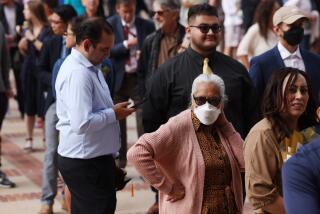Health food not on the menu for many California teens
- Share via
Californians have a reputation for being health-food junkies, but the truth is an estimated 2 million California teens drink at least one sugary drink a day, and more than 1.6 million eat fast food at least twice a week, according to new research. Those who live or go to school in neighborhoods where fast-food restaurants and convenience stores outnumber supermarkets tend to partake in these foods more often, according to the report from the UCLA Center for Health Policy Research.
UCLA scientists calculated the ratio of fast-food restaurants and convenience stores to grocery stores and produce vendors near teens’ homes and schools. They used the ratio as a measure of how available healthful foods were in their neighborhoods – the lower the score, the healthier the food options.
They then paired this information with surveys of more than 3,600 teens from more than 40 California counties taken in 2007. Among teenagers who went to school or lived in areas that scored a five or higher, more than half had a sugary drink at least once a day, on average, and roughly 50% had fast food at least twice a week, according to the UCLA report.
Top performing counties included Sonoma, Yuba, Contra Mesa and Mendocino, where less than 45% of teenagers had at least one soda per day, along with Shasta, Humboldt, San Luis Obispo, Mendocino and El Dorado, where less than 35% of teens ate fast food at least twice a week.
Meanwhile, more than 70% of teens in San Benito, Sutter, Merced and Fresno counties had at least one soda a day and more than 55% of teens in Tulare, Riverside, Ventura and Kern counties dined at fast-food restaurants at least twice each week.
Other studies have found similar trends in kids and adults:
- A 2009 study of more than 1 million California ninth graders found that having a fast-food restaurant within 530 feet of a high school was associated with a 5% increase in the rate of obesity.
- A 2010 study of more than 31,000 children from 1977 to 2006 reported that kids had added 168 snack calories to their daily diets, potentially adding up to more than 13 pounds of body fat per year.
- A 2011 study of more than 29,000 children estimated that teens were getting roughly one-sixth of their calories from fast food, the equivalent of roughly 330 calories – or a McDonald’s cheeseburger.
- A 2011 study of more than 5,000 African American and Caucasian men and women showed that living near fast-food restaurants was associated with eating more fast food, especially among low-income men.
The UCLA researcher didn’t collect enough data from all counties to be able to say whether these trends had an effect on obesity. But in Los Angeles County, which scored an 8.5, almost 20% of teens were overweight and another 15% were obese. And almost 60% of teenagers in the county reported drinking at least one soda a day and 45% ate at fast food least twice a week.
The authors suggest that incentives such as farmers markets, community gardens and better zoning should be implemented to promote better eating. However, recent research suggests that increased access to supermarkets alone doesn’t always do the trick. The 2011 study tracked thousands of people in several cities across the U.S and found that having a supermarket nearby didn’t prompt people to eat more fruits and vegetables.
The California Endowment, the private health foundation that funded the UCLA study, has just invested $200 million to entice businesses to provide more healthful food options in underserved neighborhoods. Local agencies are also working to get community projects going.
You can read the UCLA report online here.
More to Read
Sign up for The Wild
We’ll help you find the best places to hike, bike and run, as well as the perfect silent spots for meditation and yoga.
You may occasionally receive promotional content from the Los Angeles Times.








